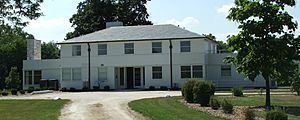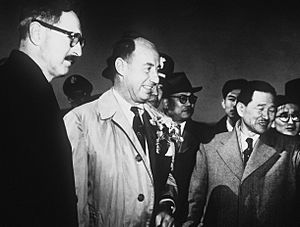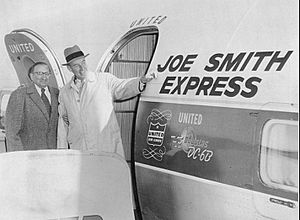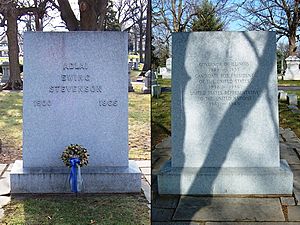Adlai Stevenson II facts for kids
Quick facts for kids
Adlai Stevenson II
|
|
|---|---|
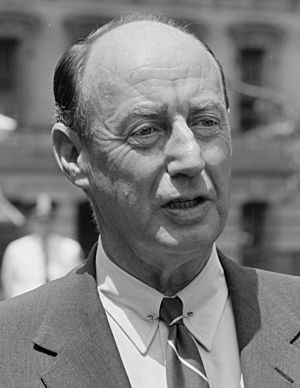
Stevenson in 1961
|
|
| 5th United States Ambassador to the United Nations | |
| In office January 23, 1961 – July 14, 1965 |
|
| President | |
| Preceded by | James Jeremiah Wadsworth |
| Succeeded by | Arthur Goldberg |
| 31st Governor of Illinois | |
| In office January 10, 1949 – January 12, 1953 |
|
| Lieutenant | Sherwood Dixon |
| Preceded by | Dwight H. Green |
| Succeeded by | William Stratton |
| Personal details | |
| Born |
Adlai Ewing Stevenson II
February 5, 1900 Los Angeles, California, U.S. |
| Died | July 14, 1965 (aged 65) Westminster, London, England |
| Resting place | Evergreen Cemetery |
| Political party | Democratic |
| Spouse |
Ellen Borden
(m. 1928; div. 1949) |
| Children | 3, including Adlai III |
| Parent |
|
| Relatives | Stevenson family Adlai Stevenson (grandfather) Adlai Stevenson IV (grandson) |
| Education | Princeton University (BA) Northwestern University (JD) |
| Military service | |
| Allegiance | |
| Branch/service | |
| Years of service | 1918 |
| Rank | |
Adlai Ewing Stevenson II (born February 5, 1900 – died July 14, 1965) was an American politician and diplomat. He served as the United States Ambassador to the United Nations from 1961 until his death in 1965. Before that, he was the 31st governor of Illinois from 1949 to 1953.
Stevenson was also the Democratic candidate for President of the United States in 1952 and 1956. He lost both elections to Dwight Eisenhower. His grandfather, Adlai Stevenson I, was the 23rd vice president of the United States.
Stevenson grew up in Bloomington, Illinois. He was a member of the Democratic Party. In the 1930s and 1940s, he worked in different roles for the U.S. government. In 1945, he helped create the United Nations and was part of the first U.S. teams there.
In 1948, he became governor of Illinois. As governor, he made changes to the state police and worked to stop illegal gambling. He also improved state roads and tried to reduce corruption in the government.
After his time as governor, he ran for president twice. In 1960, he tried for the Democratic presidential nomination again, but did not get it. When John F. Kennedy became president, he chose Stevenson to be the United States Ambassador to the United Nations. During his time as ambassador, Stevenson dealt with important events like the Bay of Pigs Invasion in 1961 and the Cuban Missile Crisis in 1962.
Stevenson was the UN ambassador until he died in London on July 14, 1965. He is buried in Evergreen Cemetery in Bloomington, Illinois.
Contents
Early Life and Education
Adlai Ewing Stevenson II was born in Los Angeles, California. His family was a well-known political family from Illinois. His grandfather, also named Adlai Stevenson I, was the Vice President of the United States from 1893 to 1897. His father, Lewis Stevenson, was the Illinois Secretary of State. A great-grandfather, Jesse W. Fell, was a close friend of Abraham Lincoln. Stevenson's oldest son, Adlai E. Stevenson III, later became a U.S. Senator.
Stevenson grew up in Bloomington, Illinois. When he was twelve, a sad accident happened at his home. While showing a rifle, it accidentally fired and killed a 16-year-old friend. Stevenson was very upset by this event and rarely spoke about it as an adult.
He attended University High School and then The Choate School. At Choate, he played tennis, acted in plays, and was editor of the school newspaper. After graduating in 1918, he joined the United States Naval Reserve. His training finished too late for him to fight in World War I.
Stevenson went to Princeton University and earned a degree in literature and history in 1922. He then tried Harvard Law School but found it uninteresting and left. He returned to Bloomington and wrote for his family's newspaper, The Daily Pantagraph. This newspaper was a major source of his family's wealth.
A year later, he became interested in law again after talking to Supreme Court Justice Oliver Wendell Holmes Jr.. He finished his law degree at Northwestern University School of Law in 1926. After passing the bar exam, he worked at a well-known law firm in Chicago.
Family and Home
In 1928, Stevenson married Ellen Borden. They had three sons: Adlai Stevenson III, Borden Stevenson, and John Fell Stevenson. In 1935, they bought land near Libertyville, Illinois, and built a home there. This home was Stevenson's official residence for the rest of his life. He was often called "The Man from Libertyville" by the news.
Adlai and Ellen divorced in 1949. Stevenson did not remarry. He dated several notable women throughout his life.
Stevenson was a Unitarian. He was a member of the Unitarian church in Bloomington. He also sometimes attended Presbyterian services. His faith helped him connect religious and ethical ideas with public issues.
Early Career
In 1933, Stevenson started working for the Agricultural Adjustment Administration (AAA), part of President Franklin D. Roosevelt's New Deal.
In 1935, he returned to Chicago to practice law. He became involved in public activities. From 1940 to 1941, he led the Chicago branch of the Committee to Defend America by Aiding the Allies. In this role, Stevenson worked to gain public support for helping the United Kingdom and its allies fight Nazi Germany in World War II. He believed that helping Britain was important for America's safety.
In 1940, Major Frank Knox, the new Secretary of the Navy, offered Stevenson a job. Stevenson wrote speeches and handled many administrative tasks for the Navy. In 1944, he went on a mission to Italy to report on the country's economy.
In 1945, Stevenson took a temporary job in the State Department. He worked on plans for a new world organization. Later that year, he went to London as a U.S. delegate to the group that created the United Nations. His work there led to more appointments to U.S. delegations to the United Nations in 1946 and 1947.
Governor of Illinois, 1949 to 1953
In 1948, Stevenson was chosen to run for governor of Illinois. He won the election against the current Republican governor, Dwight H. Green. This was a big surprise victory.
As governor, Stevenson made important changes. He reformed the state police, making hiring and promotions based on merit, not politics. He also worked to stop illegal gambling and improved state highways. He tried to reduce corruption in the Illinois government. For example, he fired a prison warden for poor management.
Stevenson also pushed for changes to the Illinois state constitution and new laws to fight crime. Most of these ideas did not pass the state legislature. However, his efforts to improve the state constitution led to changes that were approved by voters later.
During his term, there was a period known as the Second Red Scare. The Illinois state legislature passed a bill that would have made it a crime to belong to "subversive groups" and required loyalty oaths from public workers. Stevenson vetoed this bill. He said that loyalty oaths would not catch real traitors and that such laws were like those in a police state, not a democracy. He believed that America would win the "contest of ideas" by protecting its freedoms, not by limiting them.
Stevenson became known as a good public speaker. He was seen as an intellectual with a good sense of humor. One famous example of his humor came when the legislature passed a bill saying that cats roaming alone were a problem. Stevenson vetoed the bill, joking that "It is in the nature of cats to do a certain amount of unescorted roaming." He said the state had enough to do without "trying to control feline delinquency."
In 1949, Stevenson gave a sworn statement as a character witness for Alger Hiss, a former State Department official. Stevenson had worked with Hiss on United Nations projects, but they were not close friends. Stevenson stated that Hiss had a good reputation for honesty. In 1950, Hiss was found guilty of perjury. During Stevenson's 1952 presidential campaign, this statement was used by some politicians to criticize him. Stevenson defended his actions, saying that as a lawyer, it was his duty to give honest testimony in court.
1952 Presidential Bid
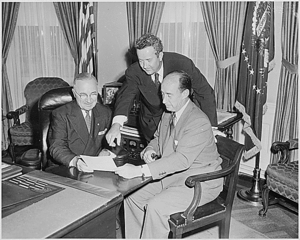
In early 1952, President Harry S. Truman decided not to run for another term. He asked Stevenson to seek the Democratic nomination for president. Stevenson was hesitant at first, saying he wanted to run for a second term as governor. However, some of his friends started a "draft Stevenson" movement, encouraging him to run for president.
Other possible Democratic candidates had weaknesses. So, Stevenson remained the most appealing choice for the 1952 Democratic National Convention in Chicago.
At the convention, Stevenson gave a welcoming speech that was so good it energized efforts to nominate him. He joked about the Republican convention that had been held earlier. He described the achievements of the Democratic Party and made fun of the Republicans' strong criticisms.
After his speech, the Illinois delegation nominated Stevenson. He called President Truman, who told him he had been trying to get Stevenson to run for months. Stevenson was nominated on the third ballot. This was the last time a major party needed more than one ballot to choose its presidential candidate. Stevenson's running mate was Senator John Sparkman of Alabama.
Stevenson's speeches and thoughtful style impressed many people. However, some Republicans called him an "egghead" because he was bald and seemed very intellectual. Stevenson joked about the nickname, saying "eggheads of the world unite, you have nothing to lose but your yolks!" He strongly criticized Senator Joseph McCarthy's methods of hunting for Communists. He called McCarthy's patriotism "a disgrace."
Stevenson also strongly disliked Richard M. Nixon, who was the Republican vice-presidential candidate. Stevenson often used his wit to attack Nixon. He once said Nixon "was the kind of politician who would cut down a redwood tree, and then mount the stump and make a speech for [tree] conservation."
During the campaign, a photo showed a hole in the sole of Stevenson's shoe. This became a symbol of his practical and down-to-earth nature. When the Eisenhower campaign tried to use the shoe to criticize him, Stevenson famously said, "Better a hole in the shoe than a hole in the head."
Stevenson did not use television as well as his opponent, Dwight D. Eisenhower. He thought selling the presidency like "breakfast cereal" was wrong. On election day, Eisenhower won by a large margin. Stevenson lost, winning only nine states. In his speech after losing, Stevenson quoted Abraham Lincoln, saying he felt like "the little boy who had stubbed his toe in the dark. He said that he was too old to cry, but it hurt too much to laugh."
Historian Jean H. Baker said Stevenson's campaign was remembered for his character, wit, and elegant speeches. He inspired many younger Americans to get involved in politics.
1953 World Tour and 1954 Elections
After his defeat, Stevenson went on a well-known world tour in 1953. He visited Asia, the Middle East, and Europe. He wrote about his travels for Look magazine. Because he was a major political figure, he met many foreign leaders.
In the 1954 elections, Stevenson actively campaigned for Democratic candidates. When Democrats won control of both houses of Congress and gained more governor seats, it strengthened his position as the party's leader.
1956 Presidential Bid
Unlike 1952, Stevenson actively sought the Democratic presidential nomination in 1956. At first, he hoped to win without entering any primary elections. However, after President Eisenhower had a heart attack, two other Democrats, Senator Estes Kefauver and Governor Averell Harriman, decided to challenge Stevenson.
Stevenson then entered and campaigned in several primaries. He lost to Kefauver in Minnesota. He then debated Kefauver on radio and television in Florida, where he won by a small number of votes. He then won the California primary, which effectively ended Kefauver's presidential campaign.
At the 1956 Democratic National Convention in Chicago, Stevenson easily won his second Democratic presidential nomination. He was supported by younger delegates. To create excitement for the Democratic ticket, Stevenson made the unusual choice to let the convention delegates choose his running mate. This led to a scramble among several prominent Democrats, including Kefauver and Senator John F. Kennedy. Kefauver won the vice-presidential nomination. In his acceptance speech, Stevenson spoke of his plan for a "New America."
Stevenson campaigned very hard, giving 300 speeches and traveling thousands of miles. He crossed the nation three times before the election.
Against the advice of many of his political advisors, Stevenson called for an international ban on aboveground nuclear weapons tests. He also called for an end to the military draft. Republicans criticized his ideas, saying they were naive. But Stevenson stood firm, saying that "Earth's atmosphere is contaminated from week to week by exploding hydrogen bombs." He warned about the dangers of increased strontium 90 in the air. Although his ideas may have cost him votes at the time, Eisenhower later suspended aboveground nuclear tests. President Kennedy signed the Partial Nuclear Test Ban Treaty in 1963, and President Nixon ended the military draft in 1973.
Civil rights was becoming a big issue. Stevenson urged caution and warned against aggressive enforcement of the Supreme Court's Brown decision. This was to gain support from white voters in the South.
Stevenson lost his second bid for the presidency by a large margin. He won only 42% of the popular vote and 73 electoral votes from just seven states.
In 1957, Stevenson returned to practicing law. He also joined the new Democratic Advisory Council, which worked to attack the Eisenhower administration and develop new Democratic policies. He also worked part-time as a legal consultant for the Encyclopædia Britannica.
1960 Presidential Campaign and Appointment as UN Ambassador
In early 1960, Stevenson said he would not actively seek a third Democratic presidential nomination, but would accept it if offered. In May 1960, Senator John F. Kennedy, who was actively campaigning, visited Stevenson. Kennedy asked Stevenson to publicly support him. In return, Kennedy promised to make Stevenson his Secretary of State if he won. Stevenson turned down the offer, which caused tension between them.
At the 1960 Democratic National Convention in Los Angeles, Stevenson's supporters strongly promoted him for the nomination, even though he was not an official candidate. Kennedy's campaign manager, his brother Robert F. Kennedy, reportedly pressured Stevenson. Stevenson refused to give in. Stevenson described both John and Robert Kennedy as "cold and ruthless." He felt that JFK was too young and inexperienced to be president.
The night before the voting, Stevenson began working for the nomination, calling state delegation leaders. However, he could not get enough support, even from his home state of Illinois. Senator Eugene McCarthy gave a passionate speech for Stevenson, but Kennedy won the nomination on the first ballot. Stevenson finished in fourth place.
Once Kennedy won the nomination, Stevenson actively campaigned for him. Because of his two presidential nominations and UN experience, Stevenson saw himself as a natural choice for Secretary of State. However, the Kennedy brothers did not think highly of Stevenson. The job of Secretary of State went to Dean Rusk. However, because of Stevenson's support from progressive Democrats, President Kennedy offered him a choice of becoming ambassador to Britain, attorney general, or United States Ambassador to the United Nations. Stevenson accepted the UN ambassador position.
It was later revealed that during the campaign, a Soviet ambassador offered Stevenson financial help if he ran for president. Stevenson immediately rejected the offer, calling it "highly improper," and reported the incident to President Eisenhower.
Ambassador to the United Nations, 1961 to 1965
As the U.S. Ambassador to the United Nations, Stevenson worked hard to support U.S. foreign policy. This was true even when he personally disagreed with some of President Kennedy's actions. However, he was often seen as an outsider in the Kennedy administration.
Bay of Pigs Incident
In April 1961, Stevenson faced a difficult situation during the Bay of Pigs invasion of Cuba. He was not fully informed about the details of the invasion. He was told it was a Cuban operation with some American cooperation, but not about the large-scale invasion or American military involvement.
Unaware that the anti-Castro Cuban exiles were being directly helped by the CIA and U.S. Navy, Stevenson unknowingly repeated a false story in a speech at the UN. He said the rebels were not assisted by the U.S. government. When this was proven false, Stevenson felt his credibility was damaged. He considered resigning, but his friends and President Kennedy convinced him to stay.
Cuban Missile Crisis
During the Cuban Missile Crisis in October 1962, Stevenson gave an important presentation at the Security Council. This presentation was shown on national television. He directly asked the Soviet UN representative, Valerian Zorin, if his country was putting nuclear missiles in Cuba. When Zorin hesitated, Stevenson demanded, "Don't wait for the translation, [answer] 'yes' or 'no'!" When Zorin said he would answer later, Stevenson famously replied, "I am prepared to wait for my answer until Hell freezes over." Stevenson then showed spy plane photos that proved the missiles were in Cuba.
Stevenson also attended meetings at the White House during the crisis. He bravely suggested a trade: the Soviets would remove their missiles from Cuba, and the U.S. would remove its older Jupiter missiles from Turkey. Some other officials strongly disagreed, seeing it as a sign of weakness. However, President Kennedy admired Stevenson for sticking to his position. Robert Kennedy later wrote that Stevenson was "courageous to make them." Stevenson himself said, "I know that most of those fellows will consider me a coward for the rest of my life for what I said today, but perhaps we need a coward in the room when we are talking about nuclear war."
The Kennedy Administration did remove the Jupiter missiles from Turkey and Italy about six months after the crisis ended. This deal was kept secret for many years.
In December 1962, an article was published that criticized Stevenson's actions during the Missile Crisis, portraying him as weak. Stevenson was very angry, especially because he believed President Kennedy himself had given the information to the journalists. Kennedy later praised Stevenson's performance publicly. However, Stevenson's friends said that the article's damage lasted, and Stevenson felt he no longer had a strong impact on foreign policy.
Kennedy Assassination and Vietnam War
As UN Ambassador, Stevenson often traveled to promote the United Nations. In October 1963, he spoke in Dallas, Texas, where he was heckled and spat upon by protestors. A woman hit him with a sign, and Stevenson remarked, "is she animal or human?" He told a policeman, "I don't want her to go to jail, I want her to go to school." Afterward, Stevenson warned President Kennedy's advisors about the "ugly and frightening" mood in Dallas.
On November 22, 1963, Stevenson learned that Kennedy had been shot in Dallas. He told friends, "That Dallas! Why, why, didn't I insist that he not go there?"
After President Kennedy was assassinated, Stevenson continued as UN Ambassador under President Lyndon Johnson. As the 1964 election approached, the Vietnam War became an important issue. Stevenson publicly supported Johnson's policy because he believed in stopping communism. However, he also wanted to start negotiations with North Vietnam through the United Nations, which Johnson did not agree with.
Death and Legacy
In July 1965, Stevenson traveled to Geneva, Switzerland, for a United Nations meeting. Afterward, he stopped in London. On July 14, while walking in London, Stevenson suffered a massive heart attack and died at age 65.
Memorial services were held at the United Nations General Assembly Hall and in several U.S. cities. Stevenson was buried in the family plot in Evergreen Cemetery, Bloomington, Illinois. Many important figures, including President Lyndon B. Johnson and Vice President Hubert Humphrey, attended his funeral.
Historian Arthur M. Schlesinger Jr. described Stevenson as a "great creative figure in American politics." He said Stevenson "brought a new generation into politics" and inspired millions.
Journalist David Halberstam wrote that Stevenson's gift was his "elegant and well-crafted, thoughtful and calming" language. His biographer Jean H. Baker said Stevenson is remembered for a "nobler, more issue-oriented" kind of politics.
The Central Illinois Regional Airport near Bloomington has a statue of Stevenson. It shows him sitting on a bench with his feet on his briefcase, wearing shoes with a hole in the sole. This refers to the famous photo from his campaign.
The Adlai E. Stevenson II Farm in Mettawa, Illinois, where Stevenson lived, is a National Historic Landmark.
In 1965, Adlai Stevenson II received the Order of Lincoln, Illinois's highest honor. In October 1965, the United States Post Office Department issued a stamp to honor him.
Things Named After Stevenson
- Stevenson Expressway – Interstate 55 is known as the Adlai E. Stevenson Expressway in Illinois.
- Adlai E. Stevenson Elementary School in Fairfield, New Jersey
- Adlai E. Stevenson Elementary School in Rochester, New York
- Adlai E. Stevenson II Elementary School in Bloomington, Illinois
- Adlai E. Stevenson High School in Lincolnshire, Illinois
- Adlai E. Stevenson High School in Sterling Heights, Michigan
- Adlai Stevenson Elementary School (formerly Junior High) in Cleveland, Ohio
- Adlai E. Stevenson High School in Livonia, Michigan
- Adlai E. Stevenson High School in Bronx, New York, now closed
- Adlai E. Stevenson Elementary School in Elk Grove Village, Illinois
- Adlai E. Stevenson Elementary School in Des Plaines, Illinois
- Adlai Stevenson Elementary School in the Plum Borough School District in Plum, Pennsylvania
- Adlai E. Stevenson Elementary School in Chicago, Illinois
- Stevenson Elementary School in Mountain View, California
- Adlai E. Stevenson College, a college at the University of California, Santa Cruz
- Stevenson Hall, a building on the Illinois State University campus in Normal, Illinois
- Adlai E. Stevenson Hall, Sonoma State University in Rohnert Park, California
- Stevenson Drive, a major road in Springfield, Illinois
- Stevenson Hall, a residence hall at Northern Illinois University in DeKalb, Illinois
- Stevenson Hall, a residence hall at Eastern Illinois University in Charleston, Illinois
- Adlai E. Stevenson Chair, a professorship at Columbia University
- Adlai Stevenson Middle School in Westland, Michigan
- Adlai E. Stevenson School, an Elementary School in Decatur, Illinois
- Adlai E. Stevenson Elementary School in Southfield, Michigan
- Stevenson Hall, a dining facility at Princeton University
- Stevenson Center for Community and Economic Development, a graduate program at Illinois State University
Electoral history
Gubernatorial
- 1948
| Party | Candidate | Votes | % | |
|---|---|---|---|---|
| Democratic | Adlai E. Stevenson | 578,390 | 100 | |
| Total votes | 578,390 | 100 | ||
| Party | Candidate | Votes | % | |
|---|---|---|---|---|
| Democratic | Adlai E. Stevenson | 2,250,074 | 57.11 | |
| Republican | Dwight H. Green (incumbent) | 1,678,007 | 42.59 | |
| Prohibition | Willis Ray Wilson | 9,491 | 0.24 | |
| Socialist Labor | Louis Fisher | 2,673 | 0.07 | |
| Write-in | Others | 12 | 0.00 | |
| Total votes | 3,940,257 | 100 | ||
- 1952
| Party | Candidate | Votes | % | |
|---|---|---|---|---|
| Democratic | Adlai E. Stevenson (incumbent) | 708,275 | 99.97 | |
| Write-in | Others | 213 | 0.03 | |
| Total votes | 708,488 | 100 | ||
Presidential
- 1952
| Presidential candidate | Party | Home state | Popular vote | Electoral vote |
Running mate | |||
|---|---|---|---|---|---|---|---|---|
| Count | Percentage | Vice-presidential candidate | Home state | Electoral vote | ||||
| Dwight David Eisenhower | Republican | New York | 34,075,529 | 55.18% | 442 | Richard Milhous Nixon | California | 442 |
| Adlai Ewing Stevenson II | Democratic | Illinois | 27,375,090 | 44.33% | 89 | John Jackson Sparkman | Alabama | 89 |
| Vincent Hallinan | Progressive | California | 140,746 | 0.23% | 0 | Charlotta Amanda Spears Bass | New York | 0 |
| Stuart Hamblen | Prohibition | Texas | 73,412 | 0.12% | 0 | Enoch Arden Holtwick | Illinois | 0 |
| Eric Hass | Socialist Labor | New York | 30,406 | 0.05% | 0 | Stephen Emery | New York | 0 |
| Darlington Hoopes | Socialist | Pennsylvania | 20,203 | 0.03% | 0 | Samuel Herman Friedman | New York | 0 |
| Douglas MacArthur | Constitution | Arkansas | 17,205 | 0.03% | 0 | Harry Flood Byrd Sr. | Virginia | 0 |
| Farrell Dobbs | Socialist Workers | Minnesota | 10,312 | 0.02% | 0 | Myra Tanner Weiss | California | 0 |
| Other | 9,039 | 0.02% | — | Other | — | |||
| Total | 61,751,942 | 100% | 531 | 531 | ||||
| Needed to win | 266 | 266 | ||||||
- 1956
| Presidential candidate | Party | Home state | Popular vote | Electoral vote |
Running mate | |||
|---|---|---|---|---|---|---|---|---|
| Count | Percentage | Vice-presidential candidate | Home state | Electoral vote | ||||
| Dwight David Eisenhower (Incumbent) | Republican | Pennsylvania | 35,579,180 | 57.37% | 457 | Richard Milhous Nixon | California | 457 |
| Adlai Ewing Stevenson II | Democratic | Illinois | 26,028,028 | 41.97% | 73 | Carey Estes Kefauver | Tennessee | 73 |
| (Unpledged electors) | (n/a) | (n/a) | 196,318 | 0.32% | 0 | (n/a) | (n/a) | 0 |
| Thomas Coleman Andrews | States' Rights | Virginia | 108,956 | 0.18% | 0 | Thomas Harold Werdel | California | 0 |
| Eric Hass | Socialist Labor | New York | 44,300 | 0.07% | 0 | Georgia Olive Cozzini | Wisconsin | 0 |
| Enoch Arden Holtwick | Prohibition | Illinois | 41,937 | 0.07% | 0 | Edwin M. Cooper | California | 0 |
| Farrell Dobbs | Socialist Workers | New York | 7,797 | 0.01% | 0 | Myra Tanner Weiss | California | 0 |
| Harry Flood Byrd Sr. | States' Rights | Virginia | 2,657 | <0.01% | 0 | William Ezra Jenner | Indiana | 0 |
| Darlington Hoopes | Socialist | Pennsylvania | 2,128 | <0.01% | 0 | Samuel Herman Friedman | New York | 0 |
| Henry B. Krajewski | American Third | New Jersey | 1,829 | <0.01% | 0 | Anna Yezo | New Jersey | 0 |
| Gerald Lyman Kenneth Smith | Christian Nationalist | Michigan | 8 | <0.01% | 0 | Charles Robertson | Michigan | 0 |
| Walter Burgwyn Jones | Democratic | Alabama | —(a) | —(a) | 1 | Herman Eugene Talmadge | Georgia | 1 |
| Other | 8,691 | 0.01% | — | Other | — | |||
| Total | 62,021,328 | 100% | 531 | 531 | ||||
| Needed to win | 266 | 266 | ||||||
See Also
 In Spanish: Adlai Stevenson para niños
In Spanish: Adlai Stevenson para niños



